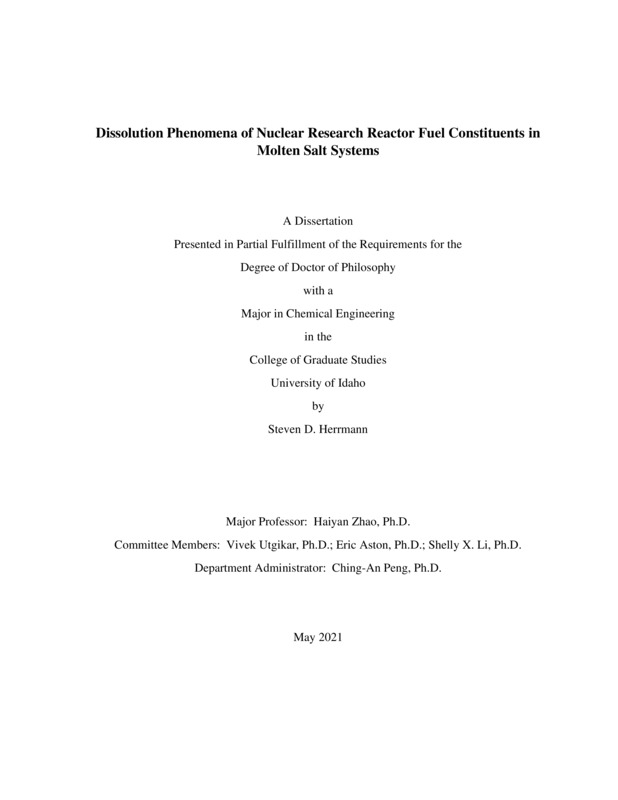Dissolution Phenomena of Nuclear Research Reactor Fuel Constituents in Molten Salt Systems
Herrmann, Steven. (2021-05). Dissolution Phenomena of Nuclear Research Reactor Fuel Constituents in Molten Salt Systems. Theses and Dissertations Collection, University of Idaho Library Digital Collections. https://www.lib.uidaho.edu/digital/etd/items/herrmann_idaho_0089e_12064.html
- Title:
- Dissolution Phenomena of Nuclear Research Reactor Fuel Constituents in Molten Salt Systems
- Author:
- Herrmann, Steven
- ORCID:
- 0000-0002-9373-4913
- Date:
- 2021-05
- Program:
- Chemical and Materials Science Engineering
- Subject Category:
- Chemical engineering
- Abstract:
-
In its 70-year history, Idaho National Laboratory has pioneered significant nuclear advancements and enduring technologies, including liquid metal reactors with an accompanying electrometallurgical treatment process for conditioning the reactor’s used metallic fuels, pressurized water reactors operating with uranium oxide fuels, and materials testing reactors operating with aluminum matrix fuels. These highly productive nuclear technology developments at the Laboratory have resulted in a legacy of nuclear fuels and materials that require stabilization prior to their ultimate disposal. A primary concern with disposal of these materials is their potential release of radioactive constituents into the biosphere. One way to lessen the burden on a repository for used nuclear fuel and materials is to process them into waste forms that are more robust than the used fuel matrix itself. Such is an outcome of the electrometallurgical treatment process, which is based on molten salt dissolution of specific metallic fuels and could be extended to other used nuclear fuels. The aim of this study was to examine molten salt dissolution techniques that could be used to address stabilization and disposition of select legacy nuclear fuels and materials at the Laboratory. Specifically, the scope of this study was limited to dissolution phenomena of nuclear research reactor fuel constituents in molten salt systems. Fuels and constituents in this study included (1) used nuclear oxide fuels, (2) aluminum matrix fuels, (3) bond sodium from metallic fuels, and (4) uranium metal and hydride to synthesize high-purity uranium trichloride for use in molten salt dissolution studies. The dissolution of used nuclear oxide fuels in molten salt systems initially involved contacting various forms of nuclear oxide fuel in molten lithium chloride – potassium chloride eutectic with 9 wt% uranium as the trichloride at 500°C. Alkali, alkaline earth, lanthanide, and transuranium constituents partitioned from the oxide fuels into the molten salt phase to varying extents with a wide range of 12 – 99%. Higher extents of fuel constituent dissolution were attributed to reducing conditions in the fuel matrix and preconditioning of the fuel. Subsequent experiments were performed in which reducing conditions in preconditioned oxide fuel were created via electrolytic and chemical-seeded means. Other parameters, including higher operating temperatures (500 to 800°C) and uranium trichloride concentrations (upwards of 19 wt% uranium as the trichloride), were investigated in these experiments, leading to fuel constituent dissolution above 90%. Dissolution of an aluminum fuel matrix involved contacting and heating neodymium metal (as a surrogate for uranium metal) and aluminum metal (in foil and particulate form) initially with lithium and ammonium chloride. The aluminum metal forms reacted into volatile aluminum chloride, separating from the neodymium metal which simultaneously reacted to form neodymium chloride and fused with the lithium chloride. Experiments were repeated with lithium and ammonium bromide to assess the performance of a bromide system vis-à-vis a chloride system. Extents of aluminum removal ranged from 94.5 – 98.2% and 91.4 – 97.8% for the chloride and bromide systems, respectively. Sodium metal was deactivated into molten salt systems via reaction with non-metal (ammonium) and metal (ferrous) chlorides. The reaction of molten sodium metal with metered ammonium chloride particulate proceeded without excursions, producing a pure colorless sodium chloride. The reaction of molten sodium with ferrous chloride yielded occasional excursions and salt fuming, producing a dark salt-metal mixture. These experiments identified a controlled technique to convert reactive and pyrophoric sodium metal into a stable sodium chloride – a technique that could be applied in a remote-handled inert-atmosphere environment with sodium metal containing elevated levels of reactivity, such as bond sodium in used nuclear metallic fuels. Uranium metal and uranium hydride were separately reacted with ammonium chloride in the presence of lithium chloride – potassium chloride eutectic to form a ternary mixture of uranium trichloride with the alkali-metal chlorides. Similar experiments were performed to synthesize a eutectic mixture of sodium chloride – uranium trichloride. Extensive characterization of the synthesized products was performed to assess their form and purity. This collection of experimental studies highlights the safety and effectiveness of molten salts at dissolving select used nuclear research reactor fuel constituents under specific conditions. When applied to used fuels, the radioactive components in the molten salt systems may be further treated, as needed, into leach-resistant, robust waste forms for ultimate disposal in a federal repository.
- Description:
- doctoral, Ph.D., Chemical and Materials Science Engineering -- University of Idaho - College of Graduate Studies, 2021-05
- Major Professor:
- Zhao, Haiyan
- Committee:
- Utgikar, Vivek; Aston, Eric; Li, Shelly
- Defense Date:
- 2021-05
- Identifier:
- Herrmann_idaho_0089E_12064
- Type:
- Text
- Format Original:
- Format:
- application/pdf
- Rights:
- In Copyright - Educational Use Permitted. For more information, please contact University of Idaho Library Special Collections and Archives Department at libspec@uidaho.edu.
- Standardized Rights:
- http://rightsstatements.org/vocab/InC-EDU/1.0/

